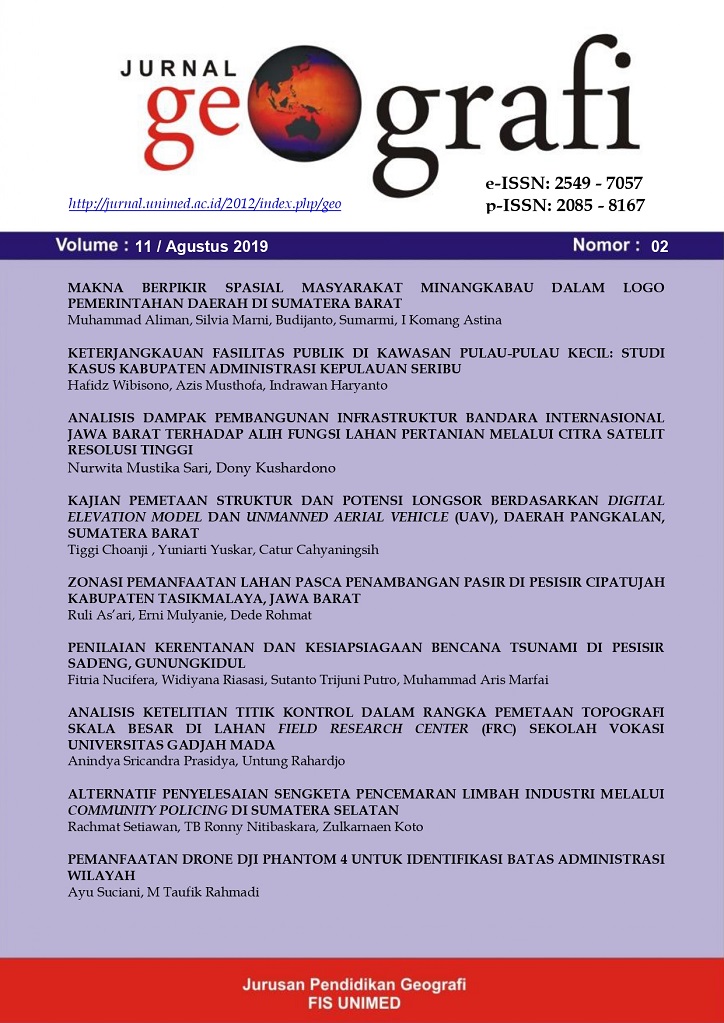Kajian Pemetaan Struktur dan Potensi Longsor Berdasarkan Digital Elevation Model dan Unmanned Aerial Vehicle (UAV), Daerah Pangkalan, Sumatera Barat
DOI:
https://doi.org/10.24114/jg.v11i2.13048Abstract
Bencana geologi berupa tanah longsor telah terjadi di beberapa tempat terutama pada jalur lintas Riau - Sumatra Barat tepatnya pada daerah pangkalan, Pangkalan Koto Baru dan sekitarnya. Penelitian ini bertujuan untuk membahas geologi struktur dan geologi kebencanaan untuk penentuan pola struktur, faktor utama terjadinya longsor dalam bentuk peta rawan bencana. Dengan menggunakan data foto udara dengan drone dan data geologi lapangan, serta dilakukan analisis diantaranya analisis foto udara, geologi struktur dengan menggunakan stereografi, analisis geologi keteknikan dengan sistem RMR (Rock Mass Rating). Hasil memperlihatkan bahwa berdasarkan 1.496 data kekar yang diambil dari 14 (empat belas) titik stasiun didapatkan beberapa arah dominan gaya yang mempengaruhi daerah tersebut, hal ini disebabkan oleh periode tektonik pra tersier dan tersier di Sumatra Tengah yang ditunjukkan dengan tegasan yang bekerja memiliki tiga arah dominan yang terekam dalam pembentukan struktur di daerah ini, yaitu tegasan bearah Utara “ Selatan , Timurlaut “ Baratdaya, dan Baratlaut “ tenggara. Berdasarkan analisis geologi teknik dengan menggunakan metode RMR, terdapat kluster 1 (satu) titik yang berada dalam kategori very poor (Kategori Klas V), 12 (duabelas) titik dalam kategori poor rock (Kategori Klas IV), dan 1 titik pada keadaan medium rock (Kategori Klas III).Kata kunci: Struktur geologi, Longsor, DEM, Rock Mass Rating, UAV, Pangkalan.Geological disasters of landslides have occurred in several locations in Riau - West Sumatra Road, Pangkalan Koto Baru and its surroundings. This study aims to discuss disaster geological structure and geology to determine structural patterns, the main mitigation factor in disaster-prone map. By using aerial photo data with drones, field geological data, the aerial photograph analyze using dense cloud analysis, structural geology using stereography, engineering geological analysis with the RMR (Rock Mass Rating) system. The results based on 1,496 solid data which obtained from 14 (fourteen) station points suggested that several dominant stress directions affect the area, which is derived from the pre-tertiary and tertiary tectonic periods in Central Sumatra. Structure are trending North - South, Northeast - Southwest, and Northwest - southeast. The RMR method, showed that there are 1 (one) cluster in the very bad category (Class V category), 12 (twelve) points in poor rock category (Class IV category), and 1 (one) in medium condition (Class III category).Key words: Structural Geology, Landslides, DEM, Rock Mass Rating, UAV, Pangkalan.References
Bieniawski, Z. T. (1973). Engineering classification of jointed rock masses. Civil Engineering = Siviele Ingenieurswese, 15(12), 335“343. Retrieved from https://journals.co.za/content/civeng/15/12/AJA10212019_17397
Choanji, T. (2016). Indikasi Struktur Patahan Berdasarkan Data Citra Satelit dan Digital Elevation Model (DEM) di Sungai Siak, Daerah Tualang dan Sekitarnya Sebagai Pertimbangan Pengembangan Pembangunan Wilayah. Jurnal Saintis, 16(2), 22“31.
Choanji, T., Nugraha, I., Sofwan, M., & Yuskar, Y. (2018). Landslide Hazard Map Using Aster GDEM 30m and GIS Intersect Method in Tanjung Alai, XIII Koto Kampar Sub-District, Riau, Indonesia BT - Proceedings of the Second International Conference on the Future of ASEAN (ICoFA) 2017 “ Volume 2. In R. Saian & M. A. Abbas (Eds.), Proceedings of the Second International Conference on the Future of ASEAN (ICoFA) 2017 “ Volume 2 (pp. 1009“1016). Singapore: Springer Singapore. https://doi.org/https://doi.org/10.1007/978-981-10-8471-3_100
Choanji, T., Yuskar, Y., Putra, D. B. E., Cahyaningsih, C., & Sakti, W. (2018). Clustering Slope Stability from Using Drone DEM Lineament Extraction And Rock Mass Rating In Pangkalan Koto Baru , West Sumatra , Indonesia. Journal of Applied Geospatial Information (JAGI), 2(2), 124“129.
Ciabatta, L., Camici, S., Brocca, L., Ponziani, F., Stelluti, M., Berni, N., & Moramarco, T. (2016). Assessing the impact of climate-change scenarios on landslide occurrence in Umbria Region , Italy.
Ciampalini, A., Raspini, F., Bianchini, S., Frodella, W., Bardi, F., Lagomarsino, D., ¦ Casagli, N. (2015). Remote sensing as tool for development of landslide databases: The case of the Messina Province (Italy) geodatabase. Geomorphology, 249, 103“118. https://doi.org/10.1016/j.geomorph.2015.01.029
Clarke, M. C. ., Kartawa, W., A. Djunuddin, E., Suganda, E., & Bagdja, M. (1982). Geological Map of The Pekanbaru Quadrane, Sumatra.
De Coster, G. L. (1974). The Geology of the Central and South Sumatra Basins. Proceedings Indonesian Petroleum Association, Third Annual Convention, June 1974, 77“110.
Erinaldi. (2017). Banjir dan Longsor Landa 50 Kota, Jalur Sumbar-Riau Mampet. Retrieved December 14, 2017, from https://www.liputan6.com/regional/read/3210675/banjir-dan-longsor-landa-50-kota-jalur-sumbar-riau-mampet
Fusao Oka, Murakami, A. &, & Kimoto, S. (2009). Prediction and Simulation Methods For Geohazard Mitigation. CRC Press.
Goel, B. S. & R. . (2011). Engineering Rock Mass Classification. Elsevier Inc.
Kumar, T., Negassa, L., & Kala, P. M. (2015). RESEARCH PAPER GIS based Grid overlay method versus modeling approach “ A comparative study for landslide hazard zonation ( LHZ ) in Meta Robi District of West Showa Zone in Ethiopia, 235“250.
Madlazim, S. B. &. (2012). Pemetaan Topografi, Geofisika dan Geologi Kota Surabaya, 2(2), 23“28.
Margottini, C., Canuti, P., & Sassa, K. (2013). Landslide Science and Practice (Vol. 7). Springer-Verlag Berlin Heidelberg.
Putra, D. B. E., & Choanji, T. (2016). Preliminary Analysis of Slope Stability in Kuok and Surrounding Areas. Journal of Geoscience, Engineering, Environment, and Technology, 1(1), 41“44. https://doi.org/10.24273/jgeet.2016.11.5
Raghuvanshi, T. K. (2019). Plane failure in rock slopes “ A review on stability analysis techniques. Journal of King Saud University - Science, 31(1), 101“109. https://doi.org/https://doi.org/10.1016/j.jksus.2017.06.004
Sassa, K., Canuti, P., Yin, Y., & Programme, T. I. (2014). Landslide Science for a Safer Geoenvironment (Vol. 1). Springer International Publishing Switzerland.
Shanmugam, G. (n.d.). The landslide problem, 4(2), 109“166.
Tanjung, C. A. (2017). Longsor di Pangkalan Sumbar Dikabarkan Telan Korban Jiwa. Retrieved March 19, 2017, from https://news.detik.com/berita/d-3437741/longsor-di-pangkalan-sumbar-dikabarkan-telan-korban-jiwa
Taylor, F. E., Malamud, B. D., Freeborough, K., & Demeritt, D. (2015). Geomorphology Enriching Great Britain ™ s National Landslide Database by searching newspaper archives, 249, 52“68.
Undang-Undang Republik Indonesia No 24 Tahun. (n.d.).
Xu, C. (2015). Geoscience Frontiers Preparation of earthquake-triggered landslide inventory maps using remote sensing and GIS technologies : Principles and case studies, 6.
Yuskar, Y., Putra, D. B. E., Suryadi, A., Choanji, T., & Cahyaningsih, C. (2017). Structural Geology Analysis In A Disaster-Prone Of Slope Failure, Merangin Village, Kuok District, Kampar Regency, Riau Province. Journal of Geoscience, Engineering, Environment, and Technology, 2(4), 249“254.
























